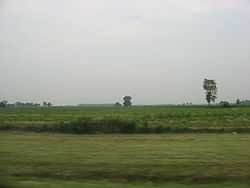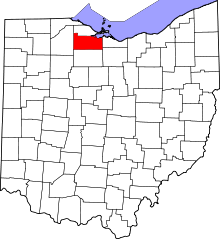Townsend Township, Sandusky County, Ohio
| Townsend Township, Sandusky County, Ohio | |
|---|---|
| Township | |
|
Across the broad fields of rural Townsend Township | |
|
Location of Townsend Township, Sandusky County, Ohio | |
| Coordinates: 41°23′6″N 82°54′15″W / 41.38500°N 82.90417°WCoordinates: 41°23′6″N 82°54′15″W / 41.38500°N 82.90417°W | |
| Country | United States |
| State | Ohio |
| County | Sandusky |
| Area | |
| • Total | 33.8 sq mi (87.6 km2) |
| • Land | 32.5 sq mi (84.1 km2) |
| • Water | 1.3 sq mi (3.5 km2) |
| Elevation[1] | 604 ft (184 m) |
| Population (2000) | |
| • Total | 1,670 |
| • Density | 51.4/sq mi (19.9/km2) |
| Time zone | Eastern (EST) (UTC-5) |
| • Summer (DST) | EDT (UTC-4) |
| FIPS code | 39-77162[2] |
| GNIS feature ID | 1086918[1] |
Townsend Township is one of the twelve townships of Sandusky County, Ohio, United States. As of the 2000 census, 1,670 people lived in the township.[3]
Geography
Located in the northeastern corner of the county, it borders the following townships:
- Margaretta Township, Erie County - northeast
- Groton Township, Erie County - southeast
- York Township - south
- Green Creek Township - southwest corner
- Riley Township - west
No municipalities are located in Townsend Township, although the unincorporated community of Vickery is located in the township's west. Prior to the settlement the southern part of the township was all heavily timbered. Extensive prairies broke the forest in the northern part. These prairies were covered with a heavy marsh grass, interspersed with an occasional branch of a more nutritious variety, which attracted the cows of the early settlers. The surface slope of the township is uniformly toward the northwest, and a number of small streams flow rapidly in that direction.
Only a faint idea can be formed by our own generation of the "appearance of things" before the white man's axe changed the condition of nature. Except in the marshy northern sections, heavy trees united their tops and completely excluded the sun. Smaller trees filled the intervening spaces below, while at many places shrubs and bushes made the forest absolutely impenetrable. Through the central part of the township walnut was the predominating heavy timber; on the ridge further south oak prevailed. Thick grape-vines, with long tendrils, bound the trees together and made it necessary in some instances to cut half a dozen trees before one could be brought to the ground. They finally came down with a crash, crossing each other in every direction. Complete clearings generally were made only where it was designed to erect the cabin. Land was first prepared for crops by cutting the smaller trees, grubbing out the underbrush, and girdling the large trees. This method of clearing saved a great deal of labor. The girdled trees soon became dry and were easily burned down during the warm months of the fall. But, although the large trees were not cut down, heavy logs had to be piled together and burned before the plow or cultivator could be used. For ages trees had been growing, dying, then falling and giving place to others. These dead and decaying trunks were lying almost concealed by underbrush. [4]
Name and history
It was ordered by the county commissioners at their April session, 1820: That a township be detached from the town of Croghanville (Fremont), to be known by the name of "Townsend," bounded as follows: Beginning on the east bank of Green Creek, at the division line between Sandusky and Seneca counties, thence east with said line to the east line of Seneca reservation, thence north along said line until it shall intersect the road leading from Croghanville to Strong's settlement, thence along said road until it shall reach the Huron county line, thence north along said line to Sandusky Bay, thence along the shore of the bay until it shall reach Green Creek, thence along the bank of the creek to the place of beginning. An old document says there were within this territory at that time more than twenty voters, but their names are not given, and early election records are lost. The establishment of Green Creek in 1822, and Riley in 1823, reduced Townsend to its present size. Statewide, the only other Townsend Township is located in Huron County.
The first settler in the township was Moses Wilson. He built his cabin on the North ridge in the spring of 1818. When the land came into market, he made a purchase and removed to the west part of the county. The Townsend family, whose name the township bears, made the second improvement on the present Brush farm, in the spring of 1818. Abraham Townsend emigrated from New York to Canada before the War of 1812. His son, Ephraim K., joined the United States army, which circumstance, together with his known sympathy with his native country, made it not only judicious, but necessary, at the opening of that unfortunate struggle, for the family to return to the States. The war over Mr. Townsend was one among the earliest of the pioneers of Northern Ohio, and in 1818 pushed into the thick and heavy forest of this county. The place of settlement had possibly been selected, during the war, by Ephraim K. The family, at the time of coming to this county, numbered two sons and five daughters, viz: Ephraim K. and Gamalial, Margaret (Chit-tendon), Betsey, wife of Addy Van Ness, Mary (Loux), Amy, and Eliza. Mr. Town-send removed to Huron county about 1824, and a few years later to Michigan. Ephraim K. remained in Townsend, where he owned eighty acres of land, until 1826, when he removed to Sandusky City, where he died the following year. Mr. Townsend was the first clerk of the township. [5]
Government
The township is governed by a three-member board of trustees, who are elected in November of odd-numbered years to a four-year term beginning on the following January 1. Two are elected in the year after the presidential election and one is elected in the year before it. There is also an elected township fiscal officer,[6] who serves a four-year term beginning on April 1 of the year after the election, which is held in November of the year before the presidential election. Vacancies in the fiscal officership or on the board of trustees are filled by the remaining trustees.
The first election was held at the house of M. Wilson. The town government of that year was as simple as possible. It was, indeed, little more than a law and order society. The land had not yet come into market, and consequently the principal business of our present official system—the collection and expenditure of taxes—was a thing of the future. Indeed, officers for the protection of personal property were unnecessary, for the citizens took into their own hands the business of inflicting punishments. [7]
References
- ↑ 1.0 1.1 "US Board on Geographic Names". United States Geological Survey. 2007-10-25. Retrieved 2008-01-31.
- ↑ "American FactFinder". United States Census Bureau. Retrieved 2008-01-31.
- ↑ Sandusky County, Ohio — Population by Places Estimates Ohio State University, 2007. Accessed 13 May 2007.
- ↑ History of Sandusky County Ohio, H.Z. Williams & Bros., 1882
- ↑ History of Sandusky County, Ohio, H.Z. williams & Bros., 1882
- ↑ §503.24, §505.01, and §507.01 of the Ohio Revised Code. Accessed 4/30/2009.
- ↑ History of Sandusky County Ohio, H.Z. Williams & Bros. 1882.
External links
| |||||||||||||||||||||||||||||||||

